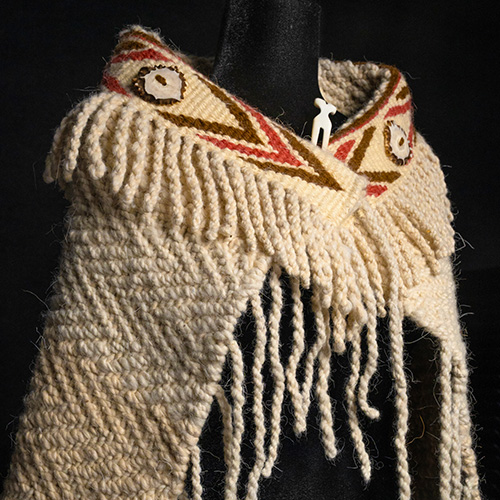Most students in Ralina Joseph’s Black Cultural Studies course were unfamiliar with Seattle’s Northwest African American Museum (NAAM) at the start of winter quarter. That wouldn’t last long.
The students visited the museum frequently during the quarter and volunteered their time as part of an unusual collaboration between the UW and the museum. The goal, says Joseph, associate professor of communication, was to have students
connect cultural studies theory with practice in the real world.

“NAAM is a tremendous resource, regionally and nationally, with a treasure-trove of narratives, photographs, and artifacts from African American communities of the Pacific Northwest,” says Joseph. “Last year I tied two Black Cultural Studies class assignments to NAAM engagement activities, at both the graduate and undergraduate levels, and students’ responses showed that they wanted more opportunities to work with the museum.”
Black Cultural Studies examines historical, social, political, legal, and media discourses about Blackness in U.S. culture. The class is crosslisted in Communication, American Ethnic Studies, and Gender, Women and Sexuality Studies. Joseph redesigned it as true collaboration with NAAM, with support from a Certificate in Public Scholarship (CPS) grant from the UW’s Simpson Center for the Humanities. She worked with two CPS fellows and staff at NAAM to plan the experimental course, using her existing syllabus as a jumping off point. The challenge, she says, was to integrate the syllabus topics and the community-based work so that “neither one was an add-on.”

The planning team identified four areas for student engagement with NAAM. One group focused on public relations, using social media and other communication strategies to publicize NAAM events. Another group developed a “story trunk” and lesson plan about artists Jacob Lawrence and James Washington, Jr., which they presented to first and second graders at neighboring Thurgood Marshall Elementary School. A third group did curatorial research on the history of artifacts from NAAM’s collection, and a fourth staffed a NAAM traveling exhibition about health disparities in the African American community, with each student researching a specific health issue featured in the exhibition.
“Planning these projects was a true collaboration,” says Chieko Phillips (MA, Museology, 2011), NAAM curatorial assistant. “It was clear from the start that Ralina wanted this to be beneficial to all parties, including the museum. And it was. All the projects were things that the museum staff wouldn’t have had time to work on.”
In addition to hands-on projects, the Black Cultural Studies course included class lectures on topics ranging from black masculinity to the Obamas as America’s First Family. In weekly writing assignments, the students explored connections between the lectures and their work at NAAM. The groups also prepared an academic poster and brief talk about their work, which they presented at an end-of-quarter celebration at NAAM with about 100 guests in attendance. “That event was our way of letting the students know that they really had helped us do our job, helped us achieve our mission,” says Phillips.
As a curator, Phillips was particularly invested in the work of the curatorial group. The students researched artifacts ranging from a trumpet used by Floyd Standifer, a Seattle jazz musician, to an advertisement for Richards and Pringle's Famous Georgia Minstrels, a minstrel troupe that performed in Tacoma. The students not only delved into the history of the artifacts but also their connection to American history and black cultural representation. Several students will present their research at the UW’s Undergraduate Research Symposium in May. One student has expressed an interest in continuing to research NAAM’s collection. “I have a list of more than 300 objects that need research, so I’m more than happy to have her continue here,” says Phillips.

The education group also made a strong impression—on classrooms full of grade schoolers. “The first and second graders at Thurgood Marshall loved the UW students that came to their class,” says Joseph. “The UW students were great role models for those kids.”
Jerry Cloud was in that group, making weekly visits to the elementary school for six weeks. The appreciation was mutual, he says. He so enjoyed the classroom experience that he is now rethinking his future plans. “Because of this opportunity, a career as a teacher is something I’m now interested in,” he says. “Hopefully it will be as much fun as teaching the kids at Thurgood Marshall.”
That sort of ah-ha moment is just what Joseph and her NAAM collaborators had hoped for. “I think it’s awesome that we were at the start of their professional development,” says Phillips. “It’s great that NAAM could be a seed for that.”
More Stories

A Healing Heart Returns
In February, the UW Symphony will perform a symphony that Coast Salish elder Vi Hilbert commissioned years ago to heal the world after the heartbreak of 9/11. The symphony was first performed by the Seattle Symphony in 2006.

Coast Salish Traditions are "Woven in Wool" at the Burke
A Burke Museum exhibit, co-curated by Coast Salish weavers and Burke curators, highlights the importance of weaving to Coast Salish communities.

Demystifying Quantum
In a physics course for non-STEM majors, Professor Miguel Morales teaches quantum mechanics without the advanced mathematics most quantum courses require.